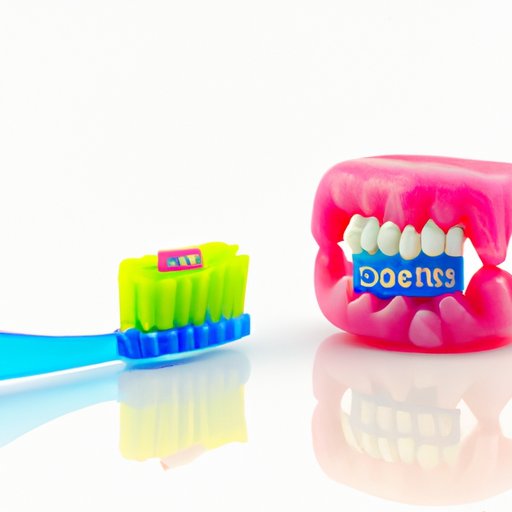Introduction
Brushing your gums is an important part of maintaining good oral health. The term “brushing your gums” refers to the process of gently scrubbing the surfaces of your gums with a toothbrush. This helps remove plaque and bacteria that can lead to gum disease, cavities, and other oral health problems. In this article, we will explore the benefits of brushing your gums and how to do it properly.

The Benefits of Brushing Your Gums
Brushing your gums is essential for maintaining optimal oral health. It has several key benefits, including:
- Removal of plaque and bacteria
- Prevention of gum disease
- Improved overall oral health
Plaque is a sticky film of bacteria that builds up on teeth and gums. If not removed, it can lead to gum disease, cavities, and other oral health problems. By brushing your gums, you can help remove plaque and bacteria from your mouth, preventing these issues from developing.
Gum disease is a common problem caused by bacteria and plaque buildup. It can result in swollen, red, and bleeding gums, bad breath, and even tooth loss if left untreated. Brushing your gums regularly can help prevent gum disease by removing plaque and bacteria before they have a chance to cause damage.
Overall, brushing your gums is an important part of maintaining good oral health. Regular brushing can help keep your teeth and gums healthy and reduce your risk of developing cavities and gum disease.

How to Properly Brush Your Gums
To properly brush your gums, follow these steps:
- Choose the right toothbrush. Look for a soft-bristled toothbrush with a small head and rounded bristles.
- Use a soft bristle brush. Harder bristles can irritate your gums, so make sure to use a soft-bristled toothbrush.
- Angle the brush in the right direction. Position the brush at a 45-degree angle against your gums and move it in gentle circular motions.
- Use gentle circular motions. Move the brush back and forth in small circles along the gum line.
- Brush for two minutes. Make sure to brush for at least two minutes to ensure that all bacteria and plaque are removed.
What Happens if You Don’t Brush Your Gums?
If you don’t brush your gums, plaque and bacteria can build up on your teeth and gums, leading to gum disease and other oral health problems. Without regular brushing, your risk of developing gum disease increases significantly. Additionally, without regular brushing, other oral health issues such as cavities and bad breath can develop.

Common Myths About Brushing Your Gums
There are several myths about brushing your gums that need to be debunked:
- Myth: brushing your gums is not necessary. This is false. Brushing your gums is essential for maintaining good oral health.
- Myth: brushing too hard will damage your gums. This is also false. While brushing too hard can irritate your gums, it won’t damage them if done properly.
Tips for Healthy Gums
In addition to brushing your gums, there are several other things you can do to maintain healthy gums:
- Floss daily. Flossing removes plaque and food particles between teeth, reducing your risk of gum disease.
- Use an antiseptic mouthwash. Antiseptic mouthwashes can help kill bacteria in your mouth and reduce your risk of gum disease.
- Avoid smoking. Smoking increases your risk of gum disease and other oral health problems.
What Kind of Toothbrush is Best for Brushing Your Gums?
The best type of toothbrush for brushing your gums is one with soft bristles. Soft bristles are gentle enough to clean your gums without irritating them. Additionally, look for a toothbrush with a small head and rounded bristles, as these are better suited for cleaning the contours of your gums.
Electric toothbrushes can also be effective for brushing your gums. These toothbrushes use vibration and rotation to clean your gums more effectively than manual toothbrushes. However, they can be more expensive and may be harder to find.
A Guide to Brushing Your Gums for Optimal Oral Health
Here is a guide to brushing your gums for optimal oral health:
- Steps to follow: Choose the right toothbrush, use a soft bristle brush, angle the brush in the right direction, use gentle circular motions, and brush for two minutes.
- Tips for proper technique: Make sure to use gentle circular motions and angle the brush at a 45-degree angle against your gums.
- Frequency of brushing: Brush your gums twice a day for two minutes each time.
Conclusion
Brushing your gums is an essential part of maintaining good oral health. It helps remove plaque and bacteria that can lead to gum disease and other oral health problems. To achieve optimal oral health, it is important to brush your gums twice a day for two minutes each time using a soft-bristled toothbrush. Additionally, floss daily, use an antiseptic mouthwash, and avoid smoking to help keep your gums healthy.
(Note: Is this article not meeting your expectations? Do you have knowledge or insights to share? Unlock new opportunities and expand your reach by joining our authors team. Click Registration to join us and share your expertise with our readers.)
